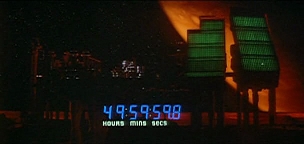
is another weird one, neither fish nor fowl. It’s another transitional fossil, from a time when Star Wars had not yet begun to ruin everything. Not that it didn’t do some good. Before the first Death Star’s destruction (spoiler alert), sci-fi films were exclusively B-listers, unfairly ghettoized, not for the content of their character, but for their budget’s relative cheapness.
Then came Spielberg. And then came George Lucus. And then came a whole horde of big budget sci-fi pictures, most long-since forgotten. So when, after taking a figurative dump on The Rock and a literal one on League of Extraordinary Gentlemen, someone requested I review a “good” Sean Connery film, I immediately thought of this one.
No, wait; that’s a lie. At first I thought of Dragonheart. But I’ve already written an intro for Outland and if I start flip-flopping now, terrorists will nerve gas San Francisco. I should know. I’m the guy with the nerve gas.
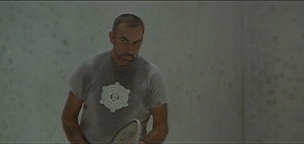
This is former Art Student/CBS News anchor Peter Hyams’ eighth film, and Hyams so obviously loved the film High Noon he decided to remake it…IN SPACE! Specifically, Jupiter’s volcanic moon, Io…which the Blinking Title Card helpfully informs us is pronounced “Eye-oh.” At this point, I turned to my hostages and said, “Do you think they put that there at the last minute because stupid people honestly couldn’t figure out how to pronounce the damn moon’s name? Was I the only kid who read Greek mythology?”
The hostages stared at me blankly. A few of them blinked. Finally, a housewife from the Palisades raised her hand and waited to be called on. She admitted that she’d mistaken it for either the number “10” or the first two letters of the word “low.” Turns out that was as much of an issue thirty years ago and “Io” was, in fact, this movie’s original title.
I mention this only to let modern SF fans know what our beloved genre was up against back in the early-80s. The Empire Strikes Back was not quite one and Blade Runner wouldn’t come out until the year later. On the other hand Outland opened up 1981’s Summer Season with its Memorial Day Weekend premiere…
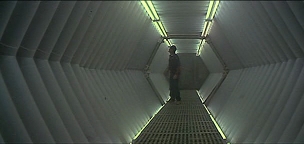
Huh. What’s this strange feeling in my gut? Is that…nostalgia? Eww! Fuckin’ gross. Just because 2011’s Memorial Day Weekend movie was…The Hangover Part II…is no reason to…actually, I take that back. Hangover Part II‘s so atrocious, you can use it to justify pretty much anything. After that, nothing is true and everything permitted. Why do you think I’m holding all these hostages?
Outland takes place inside Con-Amalgamated titanium mining station number twenty-seven. We begin the film well informed about Con-Am, thanks to the Bleeping Title Cards download into our movie from the Io Board of Tourism. We learn how many people call Con-Am 27 home, how the labor pool breaks down (they keep this thing running with less than two hundred maintenance workers? Yeah, right. Aircraft carriers employ more grease monkeys than this place) and how often the resupply shuttle arrives (once a week). Out of all these facts, only this last becomes relevant, but we’re not supposed to know that yet.
Instead, we’re supposed to marvel at all the beautiful composite job the special effects team pulled off. This allows Hyams’ camera to follow an elevator down from Con-Am 27 proper, into the Stygian abyss where they spend a year (per tour) of their lives. As the elevator opens, illuminating what’s still to this day (even on DVD) an oppressive, murky darkness, Hyams pushes back from the emerging space-suited miners, their walkway and the shelf of rock it’s perched on. Soon the miners shrink to a size I’d have to measure in pixels and Hyams slowly pans left, unveiling the mine’s true dimensions. These people are figurative ants and this is their hive: a craggy, cavernous waste with a wall of floodlights so large they look like an underground skyscraper in place of the far-too-distance sun.
Hyams used a technique called IntroVision front projection to create these shots. As the name implies, it’s the opposite of rear projection, allowing the director to layer several shots into the same image through the magic of projectors and reflective surfaces. No long post-production time, exaggerated gain, or creepy blue halos you sometimes (hell, around here that should read “more often than not”) find in movies utilizing front projection’s major competitor, the bluescreen matte.
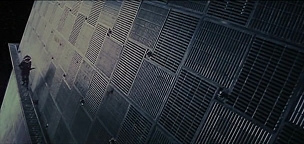
Hyams uses it to zoom through his fantastical sci-fi dystopia and find the most mundane thing he can: two working class Joes, bitching about their boss. See, the floor in Mine Shaft #8’s been creeping lately and…No, wait. Unlike some of the other small planetary bodies in our solar system, this Io remains gratefully daikaiju-free. Instead, a rash of psychotic breakdowns and apparent suicides are currently sweeping the station, so I’m sure we’ll have plenty of conflict to go around…though some giant bugs would improve things.
Instead, we find Federal Marshal William T. O’Neil (Sir Sean, fresh from his role as the Scientist in Meteor) getting ready for work. He kisses his wife (Kika Markham) goodbye, threatens to abuse his son (Nicholas Barnes), and enjoys a day of public, verbal humiliation at the hands of station Shop Steward Mark Sheppard (a very-bearded Peter Boyle – no razors on Io, I guess).
As the Shop Steward, Sheppard more-or-less runs the mine like his private fiefdom.
Sheppard: Let me tell you what you’re dealing with here. I run a franchise. The company hired me to dig as much ore out of this hellhole as possible. My hookers are clean, some of them are good looking. My booze isn’t watered. The workers are happy. When the workers are happy, they dig more ore. They get paid more bonus money. When they dig more ore, the company’s happy. When the company’s happy, I’m happy.
O’Neil: Sounds wonderful.
Sheppard: Nothing here’s “wonderful”! It works… that’s enough.
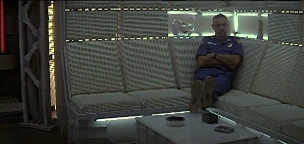
“Enough” for a man like you, maybe, Joe. But now you’re cooking with 007 stock, reduced down to its purest form: the frontier lawman with his civilized values, shipped to the ass-end of civilization. Yep. A real fish out of water. Speaking of which, someone just took the elevator down to mine-level…without a suit.
Sure, some people just can’t hack it out here (IN SPACE!!!!) and, on occasion, someone comes down with the DTs. But two in two days would set anyone’s Cop Senses tingling. After some cajoling, the station’s resident Bones, Dr. Lazarus (Frances Sternhagen), tells O’Neil there’ve been over forty suicides in the last two months. No autopsies, naturally, and the company ordered the bodies shipped back quick and quiet-like. Number 27’s a high-yield op. Wouldn’t want to jeopardize the franchise, now, would we? After all, in the last two months, this dump’s broken all previous productivity records…
You don’t need Sherlock Holmes to figure this shit out. Sheppard ships in the drugs, the workers buy them, mine more ore, get paid more money, and use their bonus to turn around and buy more drugs. Dr. Lazarus’ pre-digital computer (and check out the wall-mounted body scanner) spits out some multi-syllabic name, but c’mon, Peter: we’ve both spent some time hanging around Art students. I know bad speed when I see it, and this is some bad shit. We know this because it comes in little plastic pouches, like Capri Sun. Except it’s the color of blood. (Also like Capri Sun…which I’ve just decided to stop drinking. Last thing I need’s an imaginary spider attack.)
Topping all this off, O’Neil comes home to find his wife and son have jumped world. They caught the last shuttle out to “The Space Station” where the plan to catch a connector to Earth. As a distraught Carol O’Neil explains this in via vlog, she just can’t take it anymore. The years of frequent reassignment, recycled air, and creeping claustrophobia have finally gotten to her. And while breaking up via message (be they voice, text or video) is always a major dick move, I applaud the movie for throwing in this little point.
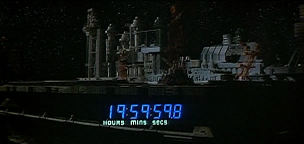
This is what sci-fi can be when its creators set their so-called minds to something other than CGI backgrounds crammed full of distracting, indecipherable shit. From now on, whenever people ask me what I mean by “character-driven SF stories” I can point them to Carol O’Neil’s breakup speech in Outland and say, “Pretty much that. Now that stop asking.”
Outland‘s first half is a half-hour short about a cop’s marriage falling apart, punctuated every seven minutes or so by the kind of grisly, space-based deaths that leave you decorating walls. With no home life and no urge to visit the company hookers, O’Neil pours all of himself into a personal crusade. He will smash Sheppard’s drug ring, come hell or hard vacuum, and no amount of intimidation or Obvious Betrayals are going to stop him.
The back half of the movie’s a long game of escalation. O’Neil wins the Banter-off, so Sheppard sics some thugs on him. O’Neil jails a thug, so Sheppard has the thug killed in stir. O’Neil flushes a shipment of Space Speed, so Sheppard’s thugs leave a deputy’s corpse hanging in O’Neil’s locker. O’Neil refuses to fuck off, so Sheppard calls in some outside talent, setting up the third act’s literal ticking clock. This is a solid, professional film, full of striking imagery, carefully arranged by a director with a painter’s eye.
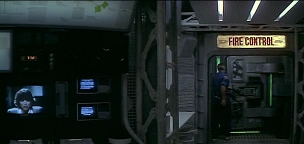
So why isn’t it as famous or fondly remembered as other, lesser, early-80s, cheesy sci-fi thrillers? The best answer I can come up with is, It takes all kinds to make a fandom. And if you’re a certain type of movie-watcher, Outland‘ll probably bore you to tears. In fact, during its original run, the film managed to alienate a whole swaths of the movie-goers by daring to rip-off that saintly, Gary Cooper Western, High Noon (which pissed off plenty of people in its own right, during its original run: “A Western without barfights or chase scenes? OUTRAGEOUS!” Like many saints, it only gained its title after everyone involved died.)
Like High Noon, Outland wants you to think the main conflict’s between the Marshal and the Bad Guy, here recast as an Evil Capitalist…but that’s okay. Hell, Western’s practically invented the archetype, and the movie makes it work. Sheppard’s no Carter Burke, though. There’s not a spec of slime on this guy. He never raises his voice and only directly threatens Sheppard once. Yet he carries this (in truth, secondary) conflict off by putting on an air of pure Jimmy Hoffa menace. A Blue Collar Evil, in contrast to Connery’s uniform…and everything it symbolizes. The kind of guy who’s perfect for carving kingdoms out of chaos. The kind of guy makes points with other people’s corpses.
Opposed by the kind of guy who’ll put responsibility before relatives, people before profits, and The Law before personal gain. All through this movie, O’Neil hears about how foolish he is to take a stand and oppose Sheppard. (Again, how loaded a name is that?) After all, it works. Except for the whole…ya know…driving people to suicide. That counts as “working” right? Sheppard, Dr. Lazarus, his deputies…all of them call O’Neil’s moral and ethical certitude “stupid” because Outland‘s is a future where such basic, entry-level heroism’s become patently unbelievable.
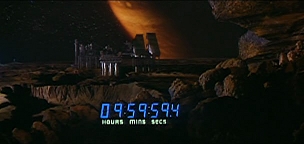
Until the end, when O’Neil sits down with Dr. Lazarus to explain the point, and where this film really diverges from High Noon (besides the whole “Jupiter’s moon” thing). Western’s are generally all about Civilization conquering a savage wilderness with Law, Order and Justice. High Noon‘s real conflict lay between the Marshall and a bunch of townsfolk too scared to stand with him against the forces of Lawlessness.
Sci-Fi dystopias, on the other hand, depict a time when Civilization extends to the stars, swallowing everything in its path. Vast and arrogant, it’s no wonder its grown corrupt, or bred corrupt men like Sheppard. Hell, thanks to Civilization’s habit of exploiting everything, “corrupt” ain’t even the right word. “Apathetic” feels better, and since mass apathy does so much to keep our world spinning right ’round, it’s no wonder I enjoy these 80s Sci-Fi flicks more than their sunny, fun-time counterparts from the ’50s. Or the big budget Bad Movies of the modern age.
Outland‘s world is a machine, with everyone trapped in their little, interlocking parts, making up a social system as rigidly stratified (in its own way) as Imperial China. It’s Prime Directive? “Whatever works,” with “works” defined as “whatever makes that proverbial PHAT cash.”
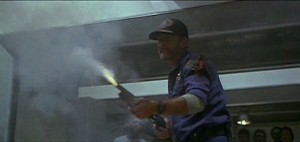
Enter a man with the insane idea of putting people’s lives ahead of resource hording. Of course he looks, sounds and acts like an alien. He’s a refuge from another time. Not the cloying, greedy, late nineteenth century, but the middle twentieth. A time when Westerns were as prevalent as Superhero movies are today. The difference being, back then, people still believed in heroes and had not yet succumbed to the tyranny of “it works.”
And if you’re thinking, Well, shit, son, that’s just the way it outta be; we can be heroes…if just for one day, then stand forth so that I may publicly embrace you as my sibling. If not…well, you probably clicked off as soon as I started over-thinking the movie’s themes. Back up top, at the level where the film meets your eyes, you’ve got a decent sci-fi thriller movie with Sean Connery playing a taciturn badass and Frances Sternhagen as…a female version of me, pretty much. Cynical, acerbic, fond of the occasional drinking binge…if she’d been the main character, this movie would be excellent and I’d be happily air-guitaring my way through it, and this review.
But I’m all too aware of modern audiences unwillingness to give slow films the time of day. At times, Outland‘s pace becomes downright glacial, and (in an unforgivable move, by modern standards) there are no twists waiting around to surprise you in the third act. It’s a country simple movie, a meat and potatoes Sci-fi Western from a time when such things were possible. If you love Alien (and love-hate Civilization) as much as I do, you’ll find a lot to chew on here. If not, go watch The Rock again.
But fair warning: if you do, these hostages won’t be going anywhere…
![]()
![]()
![]()
![]()
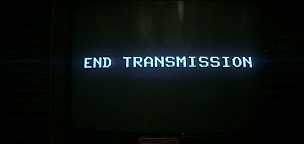

I suspect that part of why Outland isn’t more remembered is that it is such a straight forward film. There are no aliens, no goofy robots, no mutants, no Message, no mad science macguffins and no surprise twists (Soylent Green is people!). It just does its job. It’s the sort of movie that folks who like cop dramas would like, except the damned thing is set in space so they probably don’t know it exists.
I’ll have to test that theory. I know some folks, and they sure do like their Cop Dramas, so I’ll have to expose them to this film on our next Drunken Movie Night and document the results.
Nice way of putting it, too. “It does its job.” One could say Outland “works” if one wanted to be snide. (I know: me? Snide? Naw,,,! Say it ain’t so.)
I like Outland. That slow pace creates tension, something I wish a lot of current filmmakers would pay more attention to. One of my favorite guys is actually M. Night. Shamalyan, laugh if you must, but he also understands how to slow things down and let you get that creepy feeling.
On the other hand, I read Harlan Ellison’s comments on Outland written shortly after it came out and I can’t watch it without thinking of them. Things like blood that doesn’t coagulate, assasins that can’t hit a damn thing (maybe that’s why they need the super-sights?), a community of roughnecks unwilling to stand up after 40 of them commit suicide… I don’t know if Mr. Ellison can write a better movie, but it made me look at the details a lot more, both in Outland and all those other movies I’ve watched over the years.
Anyway, fun movie that falls apart a little when you think about who, what, where, why, and how.
I don’t dare laugh at anyone’s directorial favorites, considering some of my own. Besides, I agree: he may have flamed out completely when it comes to things like storytelling, but Shyamalan knows suspense beats better than I know kaiju films.
Glad to hear the appreciation of slow-boiling films isn’t as alien as I’d feared. And Harlan…dear Harlan…he’s got a point. Several good ones, in fact. The big thing that got me (and this isn’t confined to Outland; far from it) was, no surprise, the film’s handling of explosive decompression, which emphasized the “explosive” part at the expense of the “decompression.” In space, it doesn’t matter that no one can hear you explode, because human skin is tough enough to take the change from one atmosphere (i.e., “the human norm”) to zero. Our lungs, blood vessels, ear drums, and eyeballs, on the other hand, aren’t. They might explode, sure, but that won’t leave you looking like the unfortunates of Con-Am 27. Most of them wind up looking like human guinea pigs, cast off from failed experiments with Seth Brundle’s teleportation pods.
But that’s movie SF for us, where spectacle always trumps science. Something Ellison knows, and has railed against, ever since Star Trek: The Slow-Motion Picture. really, he should save all that hate for 2001. It’s all that film’s fault.
If we must err, let us err on the side of people in spacesuits exploding.
Indeed, Ace. Sage words.
I need to check this out again. I last saw it when I was probably a pre-teen and I don’t remember much, other than it looked cool, Connery, shotguns in space, and head explosions. Since I now appreciate slow movies and Westerns much more than I did then this could be a winner.
Let me know if that holds true. Don’t wanna steer you wrong.
Maybe I’ll be far along enough in my Movie of the Day entries that I’ll even……review it!
Uh-oh. You said it. On the internet. Where embarrassing statements never die! Now you have no choice.
Peter Hyams comes across as a talented action director but like him and Martin Campbell, they tend to choose mediocre to down right awful films. The only Hyams film I have enjoyed is Capricorn One; It’s quite stupid but a hell of a lot of fun.
Well, when you put it like that, it sounds kinda like a dinner bell ringing. To me, anyway.
I just hate those “conspiracy” movies that play on popular conspiracys, especially when they are not even that well crafted. That’s only dumb thing about Capricorn One but I’d reccomend it because it is a decent thriller with an good cast.
I haven’t seen this since the early days of H.B.O., and only remember being startled by the sight of James Bond in nothing but a t-shirt and tightie-whities,and not understanding why. Must revisit.
And speaking of “dear” Harlan (what would he say about THAT?), have you read his excellent book “Watching”? Every film critic (armchair OR professional) should. He is at once brilliant, angry, and unforgiving. Also,I saw an interview with him once where he railed against the saying ‘have your cake and eat it too.’ (“Shouldn’t it be ‘eat your cake and HAVE it too’ ?”) Think about it – he was absolutely right……
Yes, you should revisit it. If only as a contrast to the largely-empty light shows that pass for SF these days.
As to reading Watching, yours is the second personal recommendation that book’s received in my earshot this week. I almost picked up a commercial copy of it but, thankfully, Ellison remains his own worst advertiser. One glance at the jacket copy was all I needed to remind myself why I haven’t picked up one of his books in over a decade. Hell, why should I? I own and operate one of “those idiot sites on the internet that truckle to ultra-maroons.” I’m supposed to Oooh and Ahhh over that juxtaposition of an obscure seventeenth century verb and a hyphenated-for-that-Silver-Age-of-Comic-Book-feel pejorative. But (unlike “dear” Harlan – and you and I both know he’d hate that) I’m not seventeen anymore (physically or mentally).
To be perfectly honest (and slightly less snide), I ODed on Ellison’s short fiction during the early 2000s. This made me all-too-familiar with his personal Bag o’ Writer Tricks (every writer has one – read enough of their stuff and you can divine all its contents). Without that, or the more interesting task of figuring out what he was going for with a particular story, I honestly don’t get all that much out of his non-fictional analysis. He hated [insert movie/book/TV show/historical event/other pop cultural artifact here] and thinks we’re all fucking morons for liking it. So what? That’s true of every critic of every medium, no matter their professional level. We’re all sitting on the arms of Roger Ebert’s chair, anyway, and that’ll be true until the day he dies (may that black day never come…or, at least, lie far, far, far in the future). If I want to see assholes dis the things I like, I can get that for free from an increasingly wide variety of “idiot sites on the internet that truckle to ultra-maroons.” Most of which come with Paypal donate buttons. This allows me to give the money that formerly kept Ellison in heart medication to lesser-known, more nuanced, and certainly more thoughtful critics.
Which is not to say I won’t read it. I am, like most writers, a gigantic hypocrite. Especially when no one’s watching, or the county library sends me an email, telling me that book I ordered is ready for pick-up.
Speaking of Connery and Bond, it’s funny to see Sir Sean two years later in Never Say Never Again. He always looked terrible he when reprises the role of James Bond. I don’t know if it’s his toupee or his weight but for some reason, he looked too old for Bond even at 41 in Diamonds Are Forever. He looked better in Never Say Never Again but he still looked like crap.
Yes, I suppose Outland was Connery’s last, desperate attempt to avoid typecasting. I can just imagine him jumping off the Bond train, making Zardoz, The Wind and the Lion and The Man Who Would Be King. I wonder how many stoic, tough guy roles he took before the Truth finally hit him. I can just imagine him waking up on the set of Time Bandits and thinking, “My God, I was so naive…they don’t really want me, do they? They want James Fucking Bond. Fine. If the slobbering ingrates want Bond so bad, they can bloody well have him.” And that’s how Never Say Never Again was born.
I always see it as Connery bumping up against age. He was too old to be a credible action hero but they kept casting him because he was ‘Sean Connery’. Then Untouchables cast him as the older advisor role and his career had a big come back.
That’s a great point, actually. Reminds me how long it’s been since I watched Untouchables.
Actually, NSNA was a result a long legal battle. James Bond author Ian Fleming used the script of what was suppose to be the first Bond film which he co-wrote with producers Kevin McClory and Jack Whittingham; Fleming never credited either of them for the book. After this, McClory basically gave EON, the Bond production company, hell for quite a few years. The first Bond film was going to be Thunderball but legal troubles with Kevin forced EON to produce Dr.No instead. When Thunderball was produced, Kevin was credited as the only producer though he didn’t do jack shit and was promised that the rights to TB would revert to him ten years later. Fast foward to 1977, The Spy Who Loved Me in production and once again McClory rears his ugly head. The original script for Spy had Blofeld and SPECTRE and McClory claimed he was the sole creator of the evil originization and the mastermind. FYI, this is why Blofeld and SPECTRE never appeared again after Diamonds Are Forever. At the same time, Kevin was gearing up to make his own Bond film whicheventually became Never Say Never Again. I have read the original script for the film, at least some of it because it was so fucking terrible, I couldn’t finish it even out of curiousity. Let’s just say, it makes Die Another Day look like The Seventh Seal. Finally, NSNA was finally produced and released. Connery reprised the role really just to piss off Albert R. Brocolli, the producer of the Bond films. Sean claimed that he screwed him out of a lot of money during his Bond tenure. Still, Albert got the last laugh because Octopussy outgrossed Never Say Never Again. Connery even admitted that the film was shit and he was too old to play Bond. Then moving on to 1997, McClory once again plans on remaking Thunderball and called it “Warhead 2000 AD”. Surprise, surprise, this is right after the huge success of Goldeneye after the series was in a six year hiatus. Then some more bull shit happened when Kevin claimed he CREATED the on-screen Bond and EON own him billions of dollars. Thankfully, the courts ruled that McClory waited far too long to make this claim and any chance of another “rogue” Bond picture went up in smoke. So there you go. I hope I didn’t bore you. 😉
Far from it. In fact, the hope of prompting comments as erudite, knowledgeable and funny as yours is exactly what motivated the move to WordPress in the first place.
Thank you ! 😉
Sorry, Fleming’s book was Thunderball.
“At this point, I turned to my hostages and said, ‘Do you think they put that there at the last minute because stupid people honestly couldn’t figure out how to pronounce the damn moon’s name? Was I the only kid who read Greek mythology?’”
In strict order of asking: yes, since most moons other than the one orbiting Earth have names that would trip up even some smart people; no, but no point in leaving the other 99.997% (approx.) of the audience in the dark. 🙂
Then I suppose, in this case as in so many others, my real beef lies with the American “educational” system its apparent failure, represented by that 99.997% of the audience. Ah well…nothing to do but try and pick up its slack. Maybe if I develop a critical style that’s entertaining enough, people won’t notice they’re being educated…unless I spill the beans and broadcast my Brilliant Plan all over the internet…ooops. Too late.
Love this review. Outland is an underrated classic. I also think it’s something a lot more gray than the movie itself depicts. How much is the choice of fighting the machine driven by his pride? At least at first? How much to have focus on? At the end, it’s good versus evil.